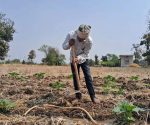NIT Rourkela researchers use machine learning to assess groundwater quality for irrigation

Rourkela: Researchers from the National Institute of Technology Rourkela (NITR) have developed a machine learning-based approach to evaluate groundwater quality for irrigation in Sundargarh district, where agriculture is the primary economic activity.
The research team, led by Anurag Sharma, assistant professor of civil engineering department, and research scholar Souvick Kumar Shaw, analysed samples from 360 wells across the district between 2014 and 2021. The study gains significance as groundwater serves as a crucial resource for irrigation in the region, where surface water sources cover only 1.21% of the district’s area.
The study revealed that groundwater in the southern, southwestern and eastern parts of Sundargarh district, including areas around Rangaimunda, Lephripara and Putudihi, is suitable for irrigation. However, the western and central parts, particularly Krinjikela, Talsara, Kutra and parts of Sundargarh town, showed higher concentrations of dissolved solids and certain cations that could potentially affect soil and crop productivity.
“Machine learning allows us to move beyond static assessments and develop predictive models that help farmers and policymakers make proactive decisions,” Sharma said, adding, “By integrating data-driven insights with traditional water management practices, we can create a more sustainable approach to irrigation and agricultural planning.”
The research identified key water quality parameters, including sodium, chloride, sodium adsorption ratio, Kelly’s ratio, permeability index and potential salinity as significant indicators affecting groundwater quality variability in the district.
The study comes at a crucial time when groundwater extraction in Sundargarh has been increasing due to growing agricultural demand, limited surface water availability and population growth. The district, where paddy cultivation occupies 76% of the net cultivable area, heavily depends on groundwater for irrigation.
The developed model has potential nationwide applications for assessing groundwater stress for irrigation purposes and can provide real-time insights for water quality management. The research findings have been published in the Water Quality Research Journal.
















